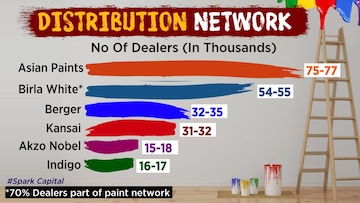From ‘Har ghar kuch kehta hai’ to ‘Jab ghar ki raunak badhani ho’ – it is the paint industry which has been an incredible support for India’s home improvement industry. For now, it has seen a fair amount of status quo, but the sector is now heating up as more players enter the space.
When one talks about the market share of companies in the paint industry, Asian Paints takes the lead with 59 percent, followed by Berger at 18 percent, Kansai Nerolac at 15 percent, and Akzo Nobel – the makers of Dulux Paints - at 7 percent.
This has largely been the case for last many years. But now, there's a lot of supply coming in. The paint industry in India is expected to add 2.5 million kilolitres of capacity over the next three years, which is about 20 percent of the existing capacity.
The total capex outlay for the industry stands at Rs 20,000 crore, 50 percent of which will come in from the big boy Grasim, which is investing Rs 10,000 crore. Asian Paints is also looking to mark its presence with a capex outlay of Rs 8,000 crore. Other companies are also investing Rs 2,000 crore for expanding their respective capacities.
Incumbents are making significant moves to expand their capacity. Asian Paints has a current capacity of 1,751 million litres, which, post-expansion, will increase to 2,636 million litres. Berger Paints will increase its capacity to 1,100 million litres from the current 620. Kansai Nerolac will also be spending Rs 290 crore to expand its current capacity of 600 million litres.
For the paint industry to see so much supply, the question is, is there enough demand?
Perhaps yes and more. According to industry experts, demand is expected to grow between 11-13 percent annually.
So who wins the market?
It all boils down to two things in the paints industry. One is distribution and second is marketing.
As far as distribution is concerned, Asian Paints has the largest number of distributors - 75,000-77,000. Grasim is eyeing the second place. Their Birla White cement channel already has 54,000-55,000 distributors and 70 percent of them are already a part of the paint network.
Similar numbers for Berger and Kansai between 31,000-35,000 whereas for Akzo Nobel and Indigo it is anywhere between 15,000 and 18,000 dealers.
Spends on advertisement
Asian Paints or all the large players spend almost up to 5 percent of their sales on advertisement but their sales basis are large as well. Whereas, Nippon and JSW Paints have eyed around 15-20 percent in terms of ad sales.
Even at lower spends as percentage of sales, on account of a high base – the absolute spends by incumbents are a lot higher and their brands well recognized.
However, there are several points to ponder regarding the future of the paint industry in India.
First is - Will established players continue to hold onto their market share through brand and distribution strength?
Second - Can new players manage to gain both margins and market share?
Third - Are lower margins becoming the new norm for the paint industry?
Fourth - Could there be some M&A action in the industry, with new players acquiring existing players or established players acquiring new players?
And lastly - Should heightened competition lead to a PE de-rating for the industry?
Overall, the disruption in the paint industry in India is creating opportunities for new players to enter the market and for existing players to expand their capacity. It remains to be seen how this disruption will play out and whether established players will be able to maintain their dominance in the industry.
For more details, watch the accompanying video
(Edited by : Hormaz Fatakia)
First Published: Mar 28, 2023 2:58 PM IST





